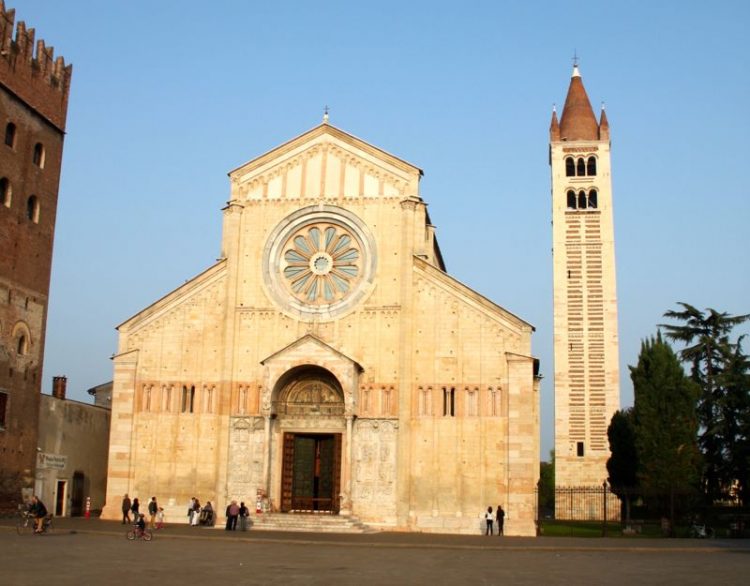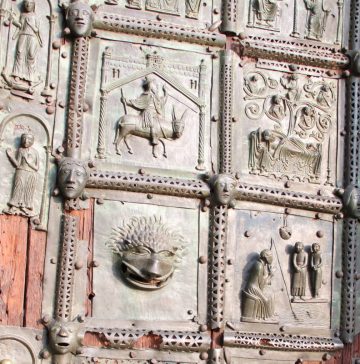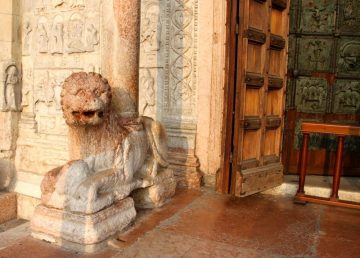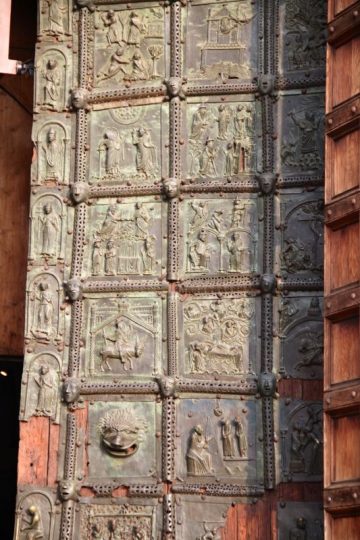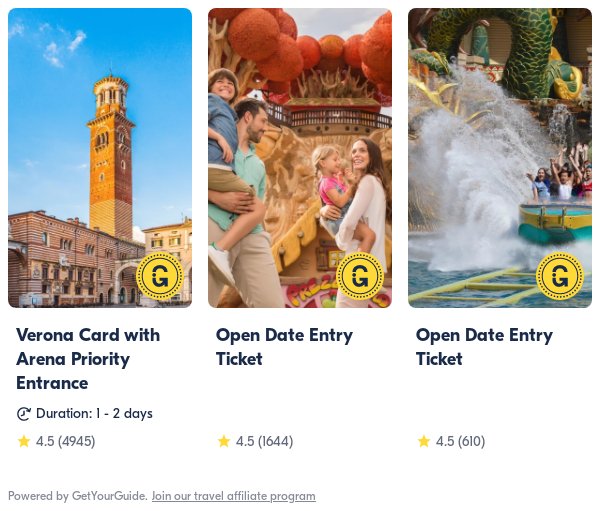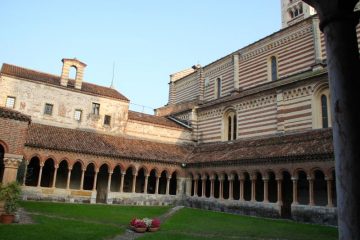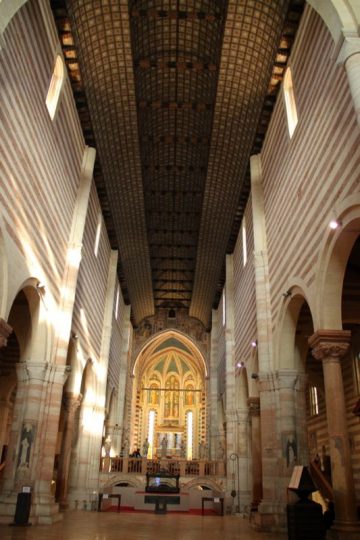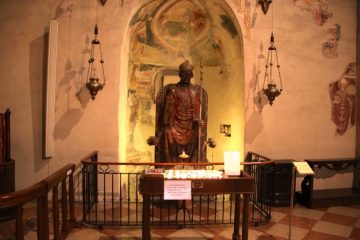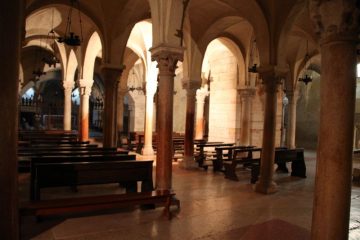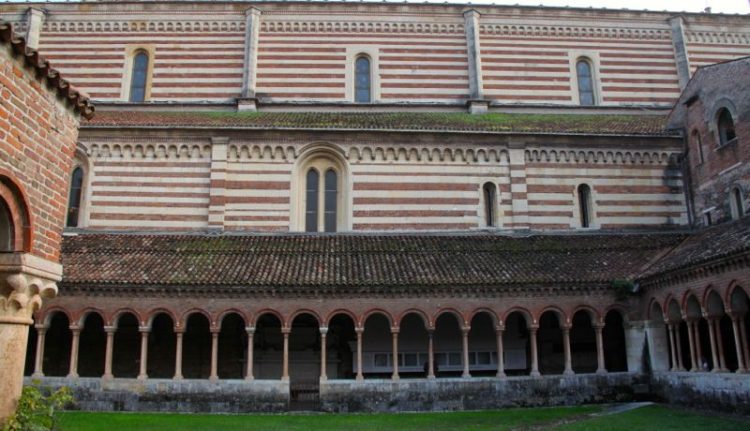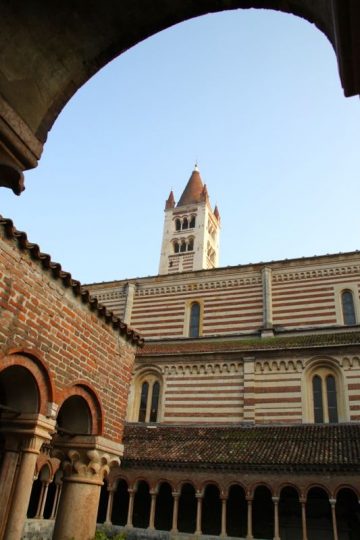The large Basilica San Zeno Maggiore is the finest church in Verona and one of the most important Romanesque churches in Northern Italy.
San Zeno Maggiore is architecturally the most important church in Verona. This large Romanesque basilica, with cloisters and a separate bell tower, was part of a Benedictine monastery that often housed the German Roman emperors. The marvelous building is easy to admire even without an understanding of all the underlying symbolism of the art and style elements. Being somewhat removed from the center of Verona, San Zeno Maggiore can be peaceful even when the rest of Verona is unpleasantly packed with day-trippers.
Saint Zeno of Verona
San Zeno Maggiore is the finest church in Verona and one of the oldest in Northern Italy. The first church was erected here in the fourth century to house the bones of San Zeno but the present building is mostly from the twelfth century, although the apse and roof are late fourteenth century. The separate campanile was completed in 1178 while the cloisters date from 1123 to 1313.
Saint Zeno (ca. 300 to 380) came from northern Africa but spent much of his life in Verona – first as monk but later as bishop. He is associated with fishing and thus often portrayed with a fishing rod. His remains are in the crypt of the church while his red marble statue in the presbytery is considered the most venerated image in Verona.
Charlemagne conquered Lombardy during the eighth century and put much of Northern Italy under Germanic rule for centuries after. The German (Holy) Roman Emperors generally treasured the region and thus often spent time and money here.
The church was part of a large Benedictine monastery – destroyed by the French during the Napoleonic era – that often housed the emperors when in Italy or en route between Rome and Germany. Only the watchtower (to the left of the church) and cloisters survived from this abbey.
The Western Façade of San Zeno in Verona
The western façade displays Romanesque elements typical for the region. Two pillars are placed on the backs of two lions – justice and faith – which are guarding the church so evil elements cannot enter. The marble bas-reliefs depict images from the Bible as well as early-medieval themes.
The tympanum has San Zeno at the center and portrays the people of Verona, as was good politics at a time when Verona was a city-state. The roof cover helped to protect much of the coloring.
However, the artistic highlight here is the magnificent bronze doors. Of the around 20 similar doors that survived in non-Byzantine Europe, these are considered to be amongst the best. The exact artist and origin of the doors are unclear. However, the doors very much remind of similar doors in Hildesheim in Germany.
Not all figures in the 48 panels can be identified but note San Zeno with a fishing rod. Furthermore, the bronze panels were not originally designed for this specific door and are probably hung out of its original chronological order.
The large rose window in the western façade is in the shape of a wheel of fortune. It was created by Brioloto (1217-25) and an early example of a style element that would be very prominent in later Gothic church designs.
The Campanile and Cloisters of San Zeno
The freestanding campanile at San Zeno is typically Romanesque. It is 72 m tall with a double row of arcades at the top. The bell tower has six bells – the first was cast in 622.
Admission to the church is usually via the cloisters on the opposite end of the church from the campanile. The beautifully restored cloisters are mostly Romanesque but some newer sections are already Gothic. It was built between 1123 and 1313.
Admission to the cloisters is free. From here, visitors can enjoy lovely views of the side of the church, with lovely horizontal stripes of pinkish-red brick and creamy tuff stone. Typical Romanesque elements include the smallish, round-arched windows and two rows of rounded arch friezes below the roof of the nave and the top of the church.
The Church of San Zeno Maggiore in Verona
The church can be divided into three main areas: the triple naves of the basilica, the lower crypt, and the elevated choir or presbytery. Artworks adorn many walls but the architectural elements are just as interesting.
The main church is typical for a Romanesque basilica with two lower side naves and the much higher main nave. Note the interesting roof – it is not flat, as is often the case in Romanesque churches, but already showing some Gothic influences. The basilica has no protruding transept and thus also no crossing.
The presbytery and choir are elevated but can still be seen from the main church. The apsis is more Gothic in style and fully painted. It was completed in 1398 and therefore around two centuries newer than the rest of the church.
The twelfth-century statue of a laughing Saint Zeno in red marble here is considered the most venerated in all of Verona.
However, the artistic highlight is the polyptych by Andrea Mantegna. This San Zeno Altarpiece (1457-60) is considered to have been the first major Renaissance artwork in Verona and served as inspiration for many local artists.
The lower three panels (predellas) are copies of the originals stolen by the French during the Napoleonic era. (The originals are on display in the Louvre and in Tours.)
The Crypt of San Zeno
The crypt of San Zeno is very large, untypical for the region, and clearly inspired by the Kaiserdom (Imperial Cathedral) in Speyer, which was a major center for the Salian emperors ruling the Holy Roman Empire at the time of present church’s construction.
This is the oldest part of the church and partly dates from the tenth century. Note the individually carved capitals of the 49 columns.
The crypt houses the remains of San Zeno, which is paraded on his feast day (April 12) or in Verona on May 21, in honor of the translation of his relic to the crypt on May 21, 807.
According to legend, Shakespeare’s Romeo and Juliette were married in the crypt. (Verona is full of authentic sights of this fictitious couple.)
Opening Hours and Admission of San Zeno
The basilica of San Zeno Maggiore is open as follows:
- November-February: Monday-Saturday 10:00-13:30 and 14:30-17:00, Sundays and festival days 12.30-17:00.
- March-October: Monday-Saturday 08:30-18:00, Sundays and Festival days 12:30-18:00. Outside the main season, it may open an hour later and close for lunch from 13:30 to 14:30.
The Basilica of San Zeno Maggiore charges admission like most other major churches in Verona but includes a handy flyer with a basic floor plan and short descriptions of the highlights. Admission is either €3 per church or €6 for a combination ticket including the Duomo, S Anastasia, S. Fermo & San Zeno). The Verona Card is accepted.
The cloisters and bronze doors can be seen for free. Admission is free for children up to 11.
Location of San Zeno Maggiore in Verona
The Basilica of San Zeno Maggiore is located to the west of central Verona. It is just over a kilometer from the Castelvecchio castle and the campanile is seen clearly from the Ponte Scaligero bridge.
The location is fortunate – it is just too far for many of the throngs of day-trippers who clog up the streets of historic Verona on weekends and holidays – but still close enough for most visitors who would enjoy the marvelous art and architecture.
From Castelvecchio, walk down Regaste S Zeno. A more pleasant route, and hardly longer, is along the pathway next to the Adige on the opposite bank of the river.
For drivers, some parking is available in front of the church.
The Basilica of San Zeno Maggiore is the best church to visit in Verona. Santa Anastasia is the largest and the Duomo (cathedral) traditionally the most important, but neither is close to the Romanesque beauty of San Zeno. In addition, the location slightly away from the tourist center of Verona makes for a much quieter and less harried sightseeing experience.
